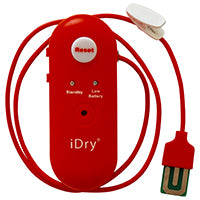1. What does my child need so that the bedwetting will stop?
Most children need to follow the steps on the DVD for three weeks and then start a bedwetting alarm while continuing the DVD steps.
2. What is a bedwetting enuresis alarm?
The alarm has a moisture sensor that sounds as soon as the child wets the bed. This sound eventually helps to get the message from the bladder to the brain and helps the child wake at night instead of wetting the bed.
3. What is the difference between a Pad and Bell alarm and a clip-on alarm?
The Pad and Bell Alarm has a mat which sits on the bed. The child lies on this and the mat connects to the alarm box on the bedside table.
The clip-on body worn alarm attaches to the child's pyjamas and a lead goes from it to the sensor which goes between two pairs of underpants or underpants and pull-ups.
4. Can my child wear pull-ups while the bed wetting is being treated?
Yes, it's OK while following the steps on the DVD and also while using a clip-on or body worn alarm.
They cannot be worn with a pad and bell alarm.
5. What alarm is best for a young child aged 5, 6 or 7?
Young children can use either type of alarm. The clip on alarm is easier to set up and reset at night especially if your child is wetting multiple times each night.
6. What is best for older children and teenagers?
We usually recommend the loudest alarm. The iDry model is the loudest and can be used as a clip-on or pad and bell alarm. Once the bedwetting is cured place the alarm mat under the fitted sheet and leave it there for six months.
7. What is the best alarm for children who wet occasionally?
The pad and bell is best as it can be set up under the fitted sheet. It is there "just in case". It can be disconnected and the alarm put away and the leads tucked under the sheet when visitors come. It does not need to be set up every night.
8. We tried an alarm before and it didn't work. Why should we try again?
By “didn't work” some parents mean the child did not wake when the alarm sounded. This is common and it is essential that the parent hears the alarm, goes in and helps the child wake up.
By following the steps on the DVD first the child is more likely to wet later in the night and this is more likely to be when they are not in a state of super deep sleep.
9. Should we see a Paediatrician?
Many children can be cured within three months using our program. We suggest if you intend to see a Paediatrician you make an appointment for three months in advance and follow our program during the three months leading up to the appointment. If your child is cured then you can cancel the appointment. If your child is not cured then you have something to report to the Paediatrician. Usually the first step a Paediatrician will recommend is to use a bedwetting alarm.
10. What about psychological issues?
Some children are under an increased amount of stress at certain times. They may sleep less deeply in certain situations and not wet, then relax and go into a very deep sleep once home again. The aim is to help children, even those living in stressful situations to stop wetting the bed.

